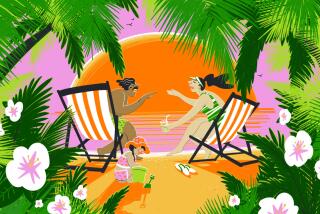Use Books and Maps to Make Vacation a Learning Experience
- Share via
If you’re going away on vacation with your child or children this summer, there are some easy and inexpensive things you can do beforehand to make the trip more fun and a better learning experience.
First, talk to your child about the trip you’ll be taking together. Tell what you know about the destination and your reasons for going. Describe the sights and activities you’re looking forward to, and then ask what the child would like to see or do.
Books can help children learn even more about the geography, history, arts and culture of your destination.
I recommend the “Kidding Around” series for grade-school kids. It covers many popular cities of the world, including Chicago, Atlanta, Paris and London. Each “Kidding Around” paperback is illustrated and costs about $10.
Another good series, the “Insight Guides,” is aimed at a teen-age audience. Each of its approximately 100 books, all with abundant color photos, offers an overview of the history and culture of a city or country. The series emphasizes European cities, but it also features such offbeat places as Bangkok, Crete, Pakistan, Leningrad and Yemen. Each paperback volume costs $19.95.
For a bigger perspective on travel and the world, try a children’s atlas. The “Rand McNally Children’s World Atlas” has excellent maps, drawings, photos and a thorough index. It costs $14.95 in hardcover.
If possible, share with your son or daughter some of the area’s culture, such as music, art, dress and food, before you go. (Bear in mind that cultural differences exist not only in other nations, but within our own country too.)
Children are usually fascinated with flags, so show the city’s or country’s flag, then explain the history behind its colors or symbols.
I highly recommend picking up a map of the city, state, region or country that is your vacation destination. They cost as little as a few dollars and come in a range of styles.
My favorite is the 34-by-40-inch U.S. coloring map made by Aneo Inc. It is erasable, comes with eight crayons and costs $6.95.
Puzzle maps are also popular and vary in difficulty from a wooden-block U.S. map to a 6,000-piece world map. One of the most interesting I’ve found is a magnetic puzzle globe made by Nouveau. Your child must create the world from scratch by sticking magnetic land and water masses onto a blank sphere.
Also novel are the place-mat maps in the “Read a Mat--Eat and Learn” series, which includes the United States, the world, the solar system and flags of major nations. Made of easy-wipe vinyl, each place mat costs $3.50.
Globes start at about $10 and come in two basic types: the standard, hard-shell kind with a stand, and inflatable.
Inflatables make great beach balls. For $39.95, you can get a 36-inch model that’s bigger than some kids.
Whatever map you come up with, spend some time going over it with your child. Start with the big picture, pointing out where you live, then your destination.
Ask a few questions. For example, is the place east or west of home? How far is it? What other cities or nations will you fly over or pass through on the way? Will you cross a time zone? What kinds of physical features, such as lakes and mountains, are visible?
Then trace the travel route on the map or globe with a pen or pencil, explaining how long you will stay and what you will do at each stop.
During the actual trip, a travel journal is a fine learning tool. You can buy a blank journal in a bookstore, but I suggest making one so you can tailor it to your trip and your child.
Just buy an inexpensive spiral notebook and tie a pen to it. Then write a different topic at the top of each page for each day of the vacation.
Some possible topics: What’s the hardest part of traveling? List some similarities and differences between this culture and your own. What’s your favorite thing about this place or culture? Describe some interesting people you have seen or met. What do you miss most about home, and why?
Besides writing, ask the child to draw pictures of places or people, and to record his or her expenditures, if any.
Once you’ve returned home, post a map on the wall and let your child retrace--with colored pens or thumbtacks--your route.
And remember that children seem to quickly forget where they’ve been or what they’ve done. So in the next year, go over the travel journal now and then with your child. This will help make the learning and memories more permanent.
Some good places to look for children’s travel books are the Children’s Book and Music Center in Santa Monica and Dutton’s in Brentwood and downtown Los Angeles.
For maps, globes, and other geographical supplies, try the California Map and Travel Center in Santa Monica or the Travel Gallery in Manhattan Beach.
More to Read
Sign up for The Wild
We’ll help you find the best places to hike, bike and run, as well as the perfect silent spots for meditation and yoga.
You may occasionally receive promotional content from the Los Angeles Times.





